Spring Security 安全框架應用原理解析
企業中數據是最重要的資源,對于這些數據而言,有些可以直接匿名訪問,有些只能登錄以后才能訪問,還有一些你登錄成功以后,權限不夠也不能訪問.總之這些規則都是保護系統資源不被破壞的一種手段.幾乎每個系統中都需要這樣的措施對數據(資源)進行保護.我們通常會通過軟件技術對這樣業務進行具體的設計和實現.早期沒有統一的標準,每個系統都有自己獨立的設計實現,但是對于這個業務又是一個共性,后續市場上就基于共享做了具體的落地實現,例如Spring Security,Apache shiro誕生了.
認證授權分析用戶在進行資源訪問時,要求系統要對用戶進行權限控制,其具體流程如圖所示:
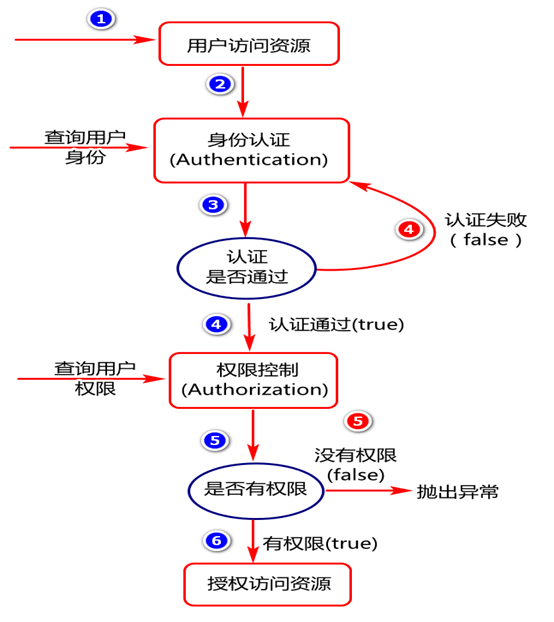
Spring Security 是一個企業級安全框架,由spring官方推出,它對軟件系統中的認證,授權,加密等功能進行封裝,并在springboot技術推出以后,配置方面做了很大的簡化.市場上現在的分布式架構下的安全控制正在逐步的轉向Spring Security.
Spring Security 基本架構Spring Security 在企業中實現認證和授權業務時,底層構建了大量的過濾器.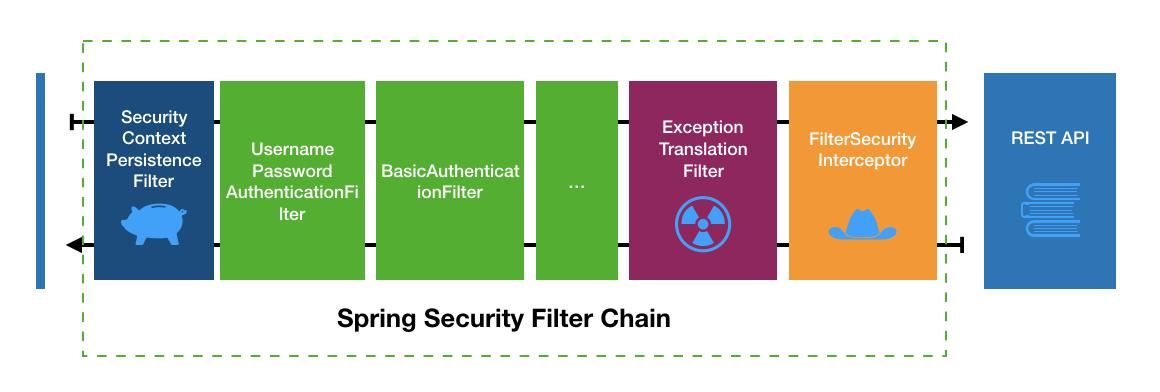 其中:綠色部分為認證過濾器,需要我們自己配置,也可以配置過個認證過濾器.也可以使用Spring Security提供的默認認證過濾器.黃色部分為授權過濾器.Spring Security就是通過這些過濾器然后調用相關對象一起完成認證和授權操作.
其中:綠色部分為認證過濾器,需要我們自己配置,也可以配置過個認證過濾器.也可以使用Spring Security提供的默認認證過濾器.黃色部分為授權過濾器.Spring Security就是通過這些過濾器然后調用相關對象一起完成認證和授權操作.
創建工程
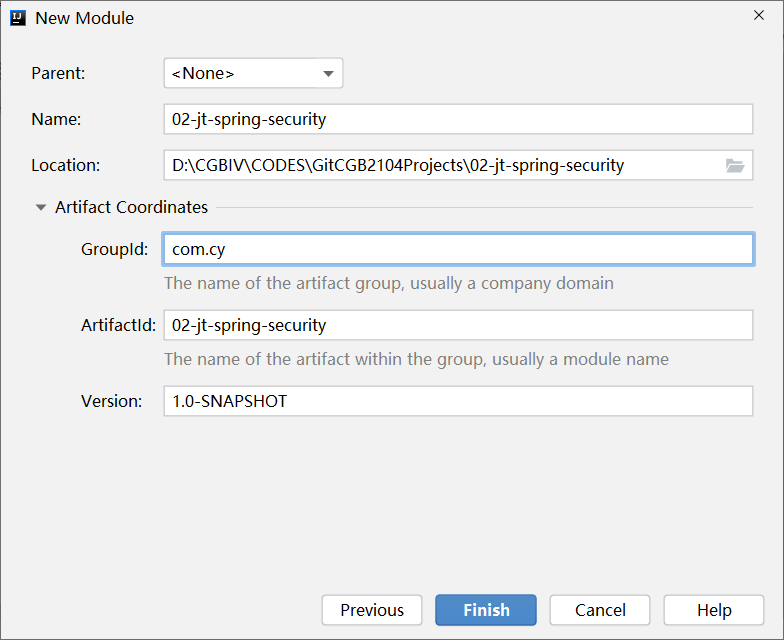
添加項目依賴
<?xml version='1.0' encoding='UTF-8'?><project xmlns='http://maven.apache.org/POM/4.0.0' xmlns:xsi='http://www.w3.org/2001/XMLSchema-instance' xsi:schemaLocation='http://maven.apache.org/POM/4.0.0 http://maven.apache.org/xsd/maven-4.0.0.xsd'> <modelVersion>4.0.0</modelVersion> <parent><artifactId>spring-boot-starter-parent</artifactId><groupId>org.springframework.boot</groupId><version>2.3.2.RELEASE</version> </parent> <groupId>com.cy</groupId> <artifactId>02-jt-spring-security</artifactId> <version>1.0-SNAPSHOT</version> <properties><maven.compiler.source>8</maven.compiler.source><maven.compiler.target>8</maven.compiler.target> </properties> <dependencies><dependency> <groupId>org.springframework.boot</groupId> <artifactId>spring-boot-starter-web</artifactId></dependency><dependency> <groupId>org.springframework.boot</groupId> <artifactId>spring-boot-starter-security</artifactId></dependency><dependency> <groupId>org.springframework.boot</groupId> <artifactId>spring-boot-starter-test</artifactId></dependency> </dependencies></project>
創建配置文件
在resources目錄下創建application.yml文件,并指定服務端口
server: port: 8080
創建項目啟動類
package com.cy.jt;import org.springframework.boot.SpringApplication;import org.springframework.boot.autoconfigure.SpringBootApplication;@SpringBootApplicationpublic class SpringSecurityApplication { public static void main(String[] args) {SpringApplication.run(SpringSecurityApplication.class,args); }}
運行啟動類訪問測試
第一步:檢查控制輸出,是否自動生成了一個密碼,例如:
Using generated security password: 360123aa-df93-4cd9-bab4-5212af421d2c
第二步:打開瀏覽器輸入http://localhost:8080,然后呈現登錄頁面,例如:
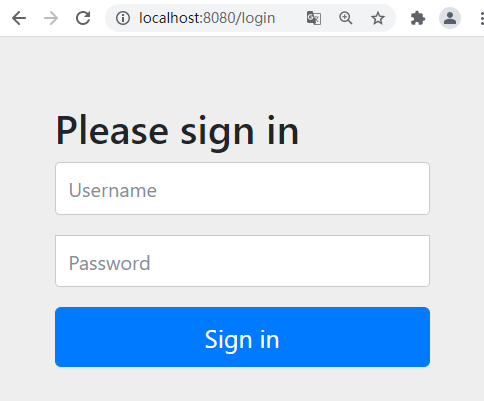
在登錄窗口中輸入用戶名user(系統默認),密碼(服務啟動時,控制臺默認輸出的密碼),然后點擊Sign in進行登錄,登錄成功默認會出現,如下界面:

在項目的resources目錄下創建static目錄,并在此目錄創建一個index.html文件,例如:
<!DOCTYPE html><html lang='en'><head> <meta charset='UTF-8'> <title>Title</title></head><body> <h1>Login Ok</h1></body></html>
啟動服務,再次進行登錄訪問測試,登錄成功以后系統默認會跳轉到index.html頁面,例如

第一步:編寫一個方法(可以在啟動類中調用執行),對一個名文進行加密,例如:
static void encodePwd(){BCryptPasswordEncoder encoder=new BCryptPasswordEncoder();String password='123456';//明文String newPwd=encoder.encode('123456');System.out.println(newPwd);//$2a$10$fahHJIe3SJm3KcyiPPQ2d.a2qR029gB3qKHrKanQ87u.KbtZ6Phr. }
第二步:將用戶和密碼在在springboot工程的application.yml文件中進行配置,例如:
spring: security: user: name: jack #password: 123456 #這種寫法,密碼太簡單了 password: ’{bcrypt}$2a$10$fahHJIe3SJm3KcyiPPQ2d.a2qR029gB3qKHrKanQ87u.KbtZ6Phr.’
其中,{bcrypt}指定了密碼加密時使用的算法
第三步:啟動服務,重新進行登錄測試.
SpringSecurity 認證邏輯實現自定義登陸邏輯SpringSecurity支持通過配置文件的方式定義用戶信息(賬號密碼和角色等),但這種方式有明顯的缺點,那就是系統上線后,用戶信息的變更比較麻煩。因此SpringSecurity還支持通過實現UserDetailsService接口的方式來提供用戶認證授權信息,其應用過程如下:第一步:定義security配置類,例如:
/** * 由@Configuration注解描述的類為spring中的配置類,配置類會在spring * 工程啟動時優先加載,在配置類中通常會對第三方資源進行初始配置. */@Configurationpublic class SecurityConfig { /** * 定義SpringSecurity密碼加密對象 * @Bean 注解通常會在@Configuration注解描述的類中描述方法, * 用于告訴spring框架這個方法的返回值會交給spring管理,并spring * 管理的這個對象起個默認的名字,這個名字與方法名相同,當然也可以通過 * @Bean注解起名字 */ @Bean //對象名默認為方法名 //@Bean('bcryptPasswordEncoder')//bean對象名字為bcryptPasswordEncoder public BCryptPasswordEncoder passwordEncoder(){return new BCryptPasswordEncoder(); }}
第二步:定義UserDetailService接口實現類,自定義登陸邏輯,代碼如下:UserDetailService為SpringSecurity官方提供的登錄邏輯處理對象,我們自己可以實現此接口,然后在對應的方法中進行登錄邏輯的編寫即可.
package com.cy.jt.security.service;@Servicepublic class UserDetailServiceImpl implements UserDetailsService { @Autowired private BCryptPasswordEncoder passwordEncoder; /** * 當我們執行登錄操作時,底層會通過過濾器等對象,調用這個方法. * @param username 這個參數為頁面輸出的用戶名 * @return 一般是從數據庫基于用戶名查詢到的用戶信息 * @throws UsernameNotFoundException */ @Override public UserDetails loadUserByUsername(String username) throws UsernameNotFoundException {//1.基于用戶名從數據庫查詢用戶信息//User user=userMapper.selectUserByUsername(username);if(!'jack'.equals(username))//假設這是從數據庫查詢的信息 throw new UsernameNotFoundException('user not exists');//2.將用戶信息封裝到UserDetails對象中并返回//假設這個密碼是從數據庫查詢出來的String encodedPwd=passwordEncoder.encode('123456');//假設這個權限信息也是從數據庫查詢到的//假如分配權限的方式是角色,編寫字符串時用'ROLE_'做前綴List<GrantedAuthority> grantedAuthorities =AuthorityUtils.commaSeparatedStringToAuthorityList('ROLE_admin,ROLE_normal,sys:res:retrieve,sys:res:create');//這個user是SpringSecurity提供的UserDetails接口的實現,用于封裝用戶信息//后續我們也可以基于需要自己構建UserDetails接口的實現User user=new User(username,encodedPwd,grantedAuthorities);return user; }}
說明,這里的User對象會交給SpringSecurity框架,框架提取出密碼信息,然后與用戶輸入的密碼進行匹配校驗.
第三步:啟動服務進行登陸,訪問測試。
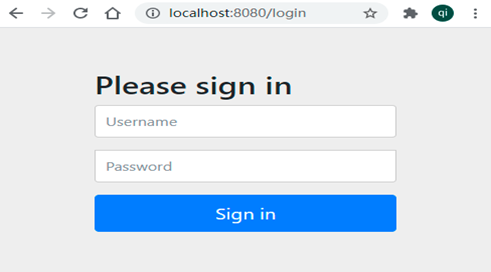

第一步:定義登陸頁面(直接在static目錄下創建即可),關鍵代碼如下:
<!DOCTYPE html><html lang='en'><head> <meta charset='utf-8'> <meta name='viewport' content='width=device-width, initial-scale=1, shrink-to-fit=no'> <meta name='description' content=''> <meta name='author' content=''> <title>Please sign in</title> <link rel='stylesheet' integrity='sha384-EVSTQN3/azprG1Anm3QDgpJLIm9Nao0Yz1ztcQTwFspd3yD65VohhpuuCOmLASjC' crossorigin='anonymous'></head><body><div class='container'> <form method='post' action='/login'><h2 class='form-signin-heading'>Please sign in</h2><p> <label for='username' class='sr-only'>Username</label> <input type='text' name='username' placeholder='Username' required autofocus></p><p> <label for='password' class='sr-only'>Password</label> <input type='password' name='password' placeholder='Password' required></p><input name='_csrf' type='hidden' value='cc1471a5-3246-43ff-bef7-31d714273899' /><button type='submit'>Sign in</button> </form></div></body></html>
注意:請求的url暫時為”/login”,請求方式必須為post方式,請求的參數暫時必須為username,password。這些規則默認在UsernamePasswordAuthenticationFilter中進行了定義。
第二步:修改安全配置類,讓其實現接口,并重寫相關config方法,進行登陸設計,代碼如下:
@Configurationpublic class SecutiryConfig extends WebSecurityConfigurerAdapter { @Bean public PasswordEncoder passwordEncoder(){return new BCryptPasswordEncoder(); } @Override protected void configure(HttpSecurity http) throws Exception {//super.configure(http);//關閉跨域攻擊,不關閉容易出錯http.csrf().disable();//自定義登陸表單http.formLogin()//設置登陸頁面.loginPage('/login.html')//設置登陸請求處理地址(對應form表單中的action),登陸時會訪問UserDetailService對象.loginProcessingUrl('/login')//設置請求用戶名參數為username(默認就是username,可以自己修改,需要與表單同步).usernameParameter('username')//請求請求密碼參數為password(默認就是password,可以自己修改,需要與表單同步).passwordParameter('password')//設置登陸成功跳轉頁面(默認為/index.html).defaultSuccessUrl('/index.html')//登陸失敗訪問的頁面(默認為/login.html?error).failureUrl('/login.html?error');//認證設計http.authorizeRequests()//設置要放行的咨詢.antMatchers('/login.html').permitAll()//設置需要認證的請求(除了上面的要放行,其它都要進行認證).anyRequest().authenticated(); }}登陸成功和失敗處理器
現在的很多系統都采用的是前后端分離設計,我們登陸成功以后可能會跳轉到前端系統的某個地址,或者返回一個json數據,我們可以自己定義登錄成功的處理操作,例如:
定義登陸成功處理器:
方案1:可以直接執行重定向的處理器,例如
package com.cy.jt.auth.config.authentication;public class RedirectAuthenticationSuccessHandler implements AuthenticationSuccessHandler {//定義要跳轉的url private String redirectUrl; public RedirectAuthenticationSuccessHandler(String redirectUrl){this.redirectUrl=redirectUrl; } @Override public void onAuthenticationSuccess(HttpServletRequest httpServletRequest,HttpServletResponse httpServletResponse, Authentication authentication) throws IOException, ServletException { httpServletResponse.sendRedirect(redirectUrl); }}
方案2:可以直接返回JSON數據的處理器,例如:
package com.cy.jt.security.config.handler;/**處理登錄失敗 * 0)Default-默認 * 1)Authentication-認證 * 2)Failure-失敗 * 3)Handler-處理器 * */public class DefaultAuthenticationFailureHandler implements AuthenticationFailureHandler { @Override public void onAuthenticationFailure( HttpServletRequest httpServletRequest, HttpServletResponse httpServletResponse, AuthenticationException e) throws IOException, ServletException {//1.設置響應數據的編碼httpServletResponse.setCharacterEncoding('utf-8');//2.告訴客戶端響應數據的類型,以及客戶端以怎樣的編碼進行顯示httpServletResponse.setContentType('application/json;charset=utf-8');//3.獲取一個輸出流對象PrintWriter out=httpServletResponse.getWriter();//4.向客戶端輸出一個json格式字符串//4.1構建一個map對象Map<String,Object> map=new HashMap<>();map.put('state','500');map.put('msg','username or password error');//4.2基于jackson中的ObjectMapper對象將一個對象轉換為json格式字符串String jsonStr= new ObjectMapper().writeValueAsString(map);out.println(jsonStr);out.flush(); }}
定義登陸失敗處理器:
方案1:登陸失敗重定向到頁面,例如
package com.cy.jt.auth.config.authentication;public class RedirectAuthenticationFailureSuccessHandler implements AuthenticationFailureHandler { private String redirectUrl; public RedirectAuthenticationFailureSuccessHandler(String redirectUrl){this.redirectUrl=redirectUrl; } @Override public void onAuthenticationFailure(HttpServletRequest httpServletRequest, HttpServletResponse httpServletResponse, AuthenticationException e) throws IOException, ServletException {httpServletResponse.sendRedirect(redirectUrl); }}
方案2:定義登陸失敗處理器,例如:
package com.cy.jt.security.config.handler;/**處理登錄失敗 * 0)Default-默認 * 1)Authentication-認證 * 2)Failure-失敗 * 3)Handler-處理器 * */public class DefaultAuthenticationFailureHandler implements AuthenticationFailureHandler { @Override public void onAuthenticationFailure( HttpServletRequest httpServletRequest, HttpServletResponse httpServletResponse, AuthenticationException e) throws IOException, ServletException {//1.設置響應數據的編碼httpServletResponse.setCharacterEncoding('utf-8');//2.告訴客戶端響應數據的類型,以及客戶端以怎樣的編碼進行顯示httpServletResponse.setContentType('application/json;charset=utf-8');//3.獲取一個輸出流對象PrintWriter out=httpServletResponse.getWriter();//4.向客戶端輸出一個json格式字符串//4.1構建一個map對象Map<String,Object> map=new HashMap<>();map.put('state','500');map.put('msg','username or password error');//4.2基于jackson中的ObjectMapper對象將一個對象轉換為json格式字符串String jsonStr= new ObjectMapper().writeValueAsString(map);out.println(jsonStr);out.flush(); }}
修改配置類,設置登陸成功與失敗處理器。
@Configurationpublic class SecutiryConfig extends WebSecurityConfigurerAdapter { @Bean public PasswordEncoder passwordEncoder(){return new BCryptPasswordEncoder(); } @Override protected void configure(HttpSecurity http) throws Exception {//super.configure(http);//關閉跨域攻擊,不關閉容易出錯http.csrf().disable();//自定義登陸表單http.formLogin()//設置登陸頁面.loginPage('/login.html')//設置登陸請求處理地址(對應form表單中的action),登陸時會訪問UserDetailService對象.loginProcessingUrl('/login')//設置請求用戶名參數為username(默認就是username,可以自己修改,需要與表單同步).usernameParameter('username')//請求請求密碼參數為password(默認就是password,可以自己修改,需要與表單同步).passwordParameter('password')//設置登陸成功跳轉頁面(默認為/index.html).successHandler(new RedirectAuthenticationSuccessHandler('你的url'))//登陸失敗訪問的頁面(默認為/login.html?error) .failureHandler(new RedirectAuthenticationFailureHandler('你的url'))//認證設計http.authorizeRequests()//設置要放行的咨詢.antMatchers('/login.html').permitAll()//設置需要認證的請求(除了上面的要放行,其它都要進行認證) .anyRequest().authenticated(); }}
第四步:啟動服務進行訪問測試(分別用正確和錯誤的賬號進行測試)。
放行靜態資源在SecurityManager配置類中的configure(HttpSecurity http)方法中我們可以通過對anMatchers方法定義要放行靜態資源,例如:
.authorizeRequests() //設置請求的授權.antMatchers( //配置下列路徑的授權'/index.html','/js/*','/css/*','/img/**','/bower_components/**','/login.html').permitAll() //設置上述所有路徑不需要登錄就能訪問(放行)
其中:
“*”用于匹配0個或多個字符 “**”用于匹配0個或多個目錄及字符登出設計及實現在SecurityManager配置類中的configure(HttpSecurity http)方法中,添加登出配置,例如
http.logout() //開始設置登出信息.logoutUrl('/logout') //登出路徑.logoutSuccessUrl('/login.html?logout');//設置登出后顯示的頁面SpringSecurity授權邏輯實現修改授權配置類
在權限配置類上添加啟用全局方法訪問控制注解,例如:
package com.cy.auth.config;//這個配置類是配置Spring-Security的,//prePostEnabled= true表示啟動權限管理功能@EnableGlobalMethodSecurity(prePostEnabled = true)@Configurationpublic class SpringSecurityConfigurer extends WebSecurityConfigurerAdapter { ……}定義資源Controller
定義一個ResourceController類,作為資源訪問對象,例如
package com.cy.jt.auth.controller;@RestControllerpublic class ResourceController { @PreAuthorize('hasAuthority(’sys:res:create’)') @RequestMapping('/doCreate') public String doCreate(){return 'add resource'; } @PreAuthorize('hasAuthority(’sys:res:update’)') @RequestMapping('doUpdate') public String doUpdate(){return 'update resource'; } @PreAuthorize('hasAuthority(’sys:res:delete’)') @RequestMapping('/doDelete') public String doDelete(){return 'delete resource'; } @PreAuthorize('hasAuthority(’sys:res:retrieve’)') @RequestMapping('/doRetrieve') public String doRetrieve(){return 'retrieve resource'; }}
其中,@PreAuthorize注解描述方法時,用于告訴系統訪問此方法時需要進行權限檢測。需要具備指定權限才可以訪問。例如:
@PreAuthorize(“hasAuthority(’sys:res:delete”) 需要具備sys:res:delete權限 @PreAuthorize(“hasRole(‘admin’)”) 需要具備admin角色 啟動服務訪問測試使用不同用戶進行登陸,然后執行資源訪問,假如沒有權限,則會看到響應狀態嗎403,如圖所示:
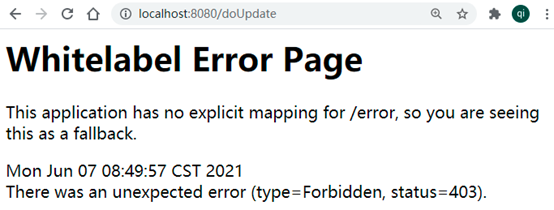
對于SpringSecurity框架而言,在實現認證和授權業務時,可能出現如下兩大類型異常:1)AuthenticationException (用戶還沒有認證就去訪問某個需要認證才可訪問的方法時,可能出現的異常,這個異常通常對應的狀態碼401)2)AccessDeniedException (用戶認證以后,在訪問一些沒有權限的資源時,可能會出現的異常,這個異常通常對應的狀態嗎為403)
異常處理規范SpringSecurity框架給了默認的異常處理方式,當默認的異常處理方式不滿足我們實際業務需求時,此時我們就要自己定義異常處理邏輯,編寫邏輯時需要遵循如下規范:1)AuthenticationEntryPoint:統一處理 AuthenticationException 異常2)AccessDeniedHandler:統一處理 AccessDeniedException 異常.
自定義異常處理對象處理沒有認證的訪問異常
package com.cy.jt.config;public class DefaultAuthenticationEntryPoint implements AuthenticationEntryPoint { @Override public void commence(HttpServletRequest request, HttpServletResponse response, AuthenticationException e) throws IOException, ServletException {//設置響應數據的編碼response.setCharacterEncoding('utf-8');//告訴瀏覽器要響應的內容類型,以及編碼response.setContentType('application/json;charset=utf-8');Map<String,Object> map=new HashMap<>();map.put('state',401);map.put('message','請先登錄');PrintWriter out=response.getWriter();out.println(new ObjectMapper().writeValueAsString(map));out.flush();out.close(); }}
處理沒有權限時拋出的異常
package com.cy.jt.config;public class DefaultAccessDeniedExceptionHandler implements AccessDeniedHandler { @Override public void handle(HttpServletRequest request, HttpServletResponse response, AccessDeniedException e) throws IOException, ServletException {//設置響應數據的編碼response.setCharacterEncoding('utf-8');//告訴瀏覽器要響應的內容類型,以及編碼response.setContentType('application/json;charset=utf-8');Map<String,Object> map=new HashMap<>();map.put('state',403);map.put('message','沒有此資源的訪問權限');PrintWriter out=response.getWriter();out.println(new ObjectMapper().writeValueAsString(map));out.flush();out.close(); }}配置異常處理對象
在配置類SecurityConfig中添加自定義異常處理對象,代碼如下
http.exceptionHandling() .authenticationEntryPoint(new DefaultAuthenticationEntryPoint()) .accessDeniedHandler(new DefaultAccessDeniedExceptionHandler());
配置完成后,重啟服務進行訪問測試分析.
系統會話狀態分析與實踐 何為會話狀態
客戶端與服務端通訊過程中產生的狀態信息(類似會議記錄),稱之為會話狀態.
會話狀態如何存儲客戶端瀏覽器與服務端通訊時使用的是http協議,這個協議本身是無狀態協議,也就是說通過此協議,無法存儲會話狀態,此時在服務端與客戶端就采用了一種Cookie與Session方式記錄會話狀態.
有狀態的會話技術分析
Cookie 技術Cookie是由服務端創建但在客戶端存儲會話狀態的一個對象,此對象分為兩種類型,一種為會話Cookie,一種為持久Cookie,瀏覽器在訪問具體的某個域名時會攜帶這個域的有效Cookie到服務端.
會話Cookie: 瀏覽器關閉Cookie生命周期結束(一般默認都是會話Cookie) 持久Cookie: 持久Cookie是在Cookie對象創建時指定了生命周期,例如一周時間,即便瀏覽器關閉,持久Cookie依舊有效. Session技術Session技術由服務端創建,并在服務端存儲會話狀態的一個對象,當Session對象創建時,還會創建一個會話Cookie對象,并且通過這個會話Cookie將SessionId寫到客戶端,客戶端下次訪問服務端會攜帶這個會話Cookie,并且通過JsessionId找到Session對象,進而獲取Session對象中存儲的數據.Cookie默認的生命周期為30分鐘.
在SpringSecurity中獲取用戶的認證信息,就可以通過如下方式進行實現:
Authentication authentication =SecurityContextHolder.getContext().getAuthentication();無狀態的會話技術分析
有狀態的會話實現,在分布式架構中可能會存在很多問題,例如瀏覽器默認不支持攜帶其它域的Cookie信息進行資源訪問,同時服務端的Session默認不能共享,當然我們有一種方式可以將session持久化到到一些數據庫,例如Redis,下次請求到其它服務器(例如tomcat)時,可以直接從redis中獲取登錄信息,但是假如并發比較大,數據庫的訪問壓力就會劇增,壓力太大有可能會導致系統宕機.所以現在還有一種方案就是將用戶的登錄狀態信息都存儲在客戶端,服務端不記錄任何狀態,服務端只負責對客戶端傳遞過來的狀態信息進行解析,基于此方式進行用戶登錄狀態的判斷,這樣的會話過程稱之為無狀態會話.
總結(Summary)重難點分析
SpringSecurity 產生背景? SpringSecurity 快速入門?(依賴,配置,登錄認證,密碼的加密-啟動生成,配置文件) SpringSecurity 認證邏輯分析及實踐?(認證方式-用戶名和密碼,登錄頁 面,SecurityConfig.UserServiceDetail,成功,失敗,放行) SpringSecurity 授權邏輯分析及實現?(為什么,授權步驟,用到的注解)FAQ 分析
如何理解認證?(判定用戶身份的合法性) 如何校驗用戶身份的合法性?(用戶密碼,指紋,刷臉,刷身份證,…) 如何進行身份認證?(自己寫認證邏輯,借助框架去寫認證邏輯-尊重框架規則) 市場上的認證和授權框架有哪些?(SpringSecurity,Shiro) 為什么會選擇SpringSecurity?(功能強大,SpringBoot誕生后在配置方面做了大量的簡化) SpringSecurity中的加密方式你用的什么?(Bcrypt,底層基于隨機鹽方式對密碼進行hash不可逆加密,更加安全,缺陷是慢) SpringSecurity中你用過哪些API?(BcryptPasswordEncoder,UserDetailService,UserDetail,User, AuthenticationSuccessHandler,AuthenticationFailureHandler,…) 為什么要進行權限控制?(防止非法用戶破壞數據) SpringSecurity進行權限控制的步驟(@EnableGlobalMethodSecurity,@PreAuthorize) SpringSecurity在進行認證和授權時可能出現的異常? SpringSecurity在未認證和未授權的前提下訪問授權資源時,出現的異常如何處理? 作業:用戶登錄成功以后,用戶信息默認存在哪里了? (Session) 作業:用戶登錄成功以后,如何獲取我們登錄的用戶信息?(這個用戶的用戶名,這個用戶的權限)Bug 分析
依賴下載不完整 響應json數據時出現文件下載到此這篇關于Spring Security 安全框架應用的文章就介紹到這了,更多相關Spring Security框架內容請搜索好吧啦網以前的文章或繼續瀏覽下面的相關文章希望大家以后多多支持好吧啦網!
相關文章:

 網公網安備
網公網安備